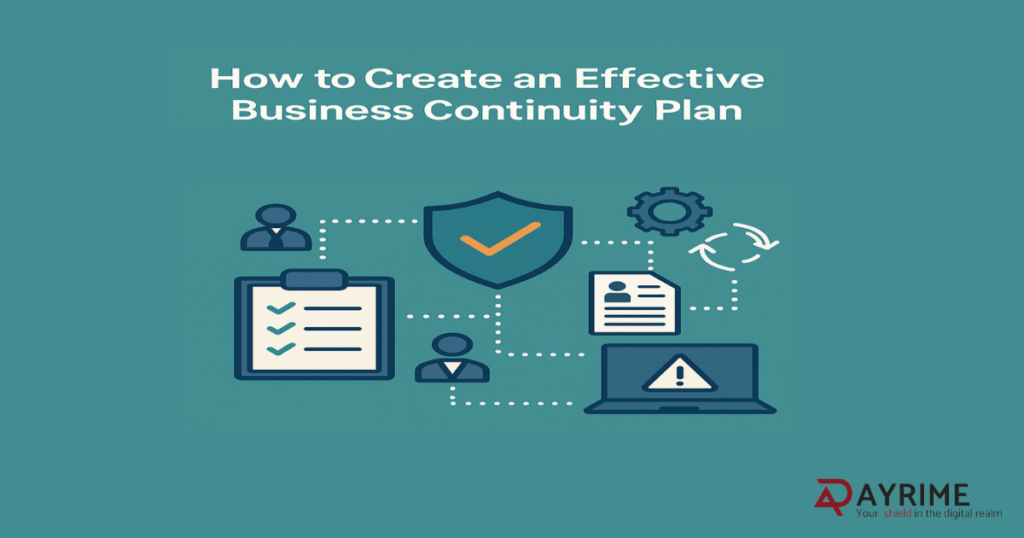Disasters don’t wait for a convenient time to strike. Whether it’s a cyberattack, a system outage, a flood, or a fire—every business, regardless of size, needs to be prepared. That’s where a Business Continuity Plan (BCP) comes in.
Yet despite the growing number of risks facing organizations today, many small and medium-sized businesses still operate without a formal continuity strategy. According to recent studies, while resilience is high on executive agendas, nearly a third of businesses aren’t confident in their ability to bounce back after a disruption.
If you’re building your first continuity plan—or need to update an outdated one—this guide will walk you through the essential steps to creating an effective, actionable BCP.

What is a Business Continuity Plan?
A Business Continuity Plan is a structured framework that helps a business continue its operations or recover quickly after a disruptive event. It includes clearly defined processes, emergency contacts, roles and responsibilities, recovery time objectives, and detailed action steps to ensure minimal downtime and impact.
Importantly, a BCP is broader than a disaster recovery plan. While disaster recovery focuses mainly on IT systems, business continuity planning covers the entire organization—from staff and suppliers to communications and critical services.
Why Every Business Needs One
For small and medium-sized enterprises (SMEs), the stakes are especially high. One prolonged outage or supply chain failure can be enough to severely damage your reputation—or even force closure.
Here’s why business continuity planning should be a top priority:
- Minimizes operational downtime
- Protects revenue and customer trust
- Meets regulatory and compliance requirements
- Reduces risk of data loss or legal repercussions
- Enables a faster, more organized recovery
It’s not just about survival—it’s about maintaining business confidence and customer trust in times of crisis.
Step-by-Step: How to Build a Business Continuity Plan
Creating an effective BCP doesn’t have to be overwhelming. Here’s a simplified roadmap to help you get started:
1. Identify Critical Business Functions
Start by mapping out the key processes that keep your business running. Ask yourself:
- What are the essential services or products we deliver?
- Which departments or systems are most critical?
- What would happen if these stopped working for 24 hours? A week?
This forms the foundation of your Business Impact Analysis (BIA)—a vital tool for prioritizing continuity efforts.
2. Assess Risks and Vulnerabilities
Every business has its own unique risk landscape. Conduct a risk assessment to identify potential threats:
- Natural disasters (floods, fires, storms)
- Cyberattacks or data breaches
- Supplier failures
- Power outages
- Human error or internal sabotage
Understanding these risks helps shape a more targeted and effective continuity plan.
3. Define Recovery Objectives
Establish two critical metrics:
- Recovery Time Objective (RTO): How quickly must a process be restored to avoid serious damage?
- Recovery Point Objective (RPO): How much data can you afford to lose?
These values will guide the design of your recovery strategies.
4. Develop Emergency Response and Continuity Procedures
This is the heart of your BCP. Define:
- Who takes the lead during a crisis?
- What are the exact steps to be taken?
- How will you communicate with employees, customers, and suppliers?
- Where are backup systems and data located?
Use checklists and flowcharts where possible to make this section easy to follow under pressure.
5. Assign Roles and Responsibilities
Clarity is crucial. List each team member’s role in a crisis and ensure backups are in place. Include:
- Emergency contacts
- Continuity coordinators
- IT and operations leads
- External vendors or service providers
6. Maintain Updated Documentation
Store the BCP in multiple formats—printed copies, digital files, and secure cloud backups. Ensure that key personnel know where and how to access the plan.
Test, Train, and Review
A plan on paper is only useful if it works in real life. Schedule regular testing and training sessions to make sure everyone knows what to do.
Types of tests include:
- Tabletop exercises: Run through scenarios in a meeting room setting.
- Walkthrough drills: Practice each team’s part of the response.
- Full-scale simulations: Test your plan as if a real incident occurred.
Regular reviews help spot gaps and keep your BCP aligned with business changes. Update your plan at least annually, and after any major organizational or technological change.
Get Leadership Buy-In and Employee Awareness
A Business Continuity Plan is only effective if people take it seriously. That means top-down support is essential. Senior leaders must:
- Champion the BCP and emphasize its importance
- Dedicate resources for training and testing
- Lead by example during simulations and reviews
Equally important is employee awareness. Integrate BCP training into onboarding and conduct refreshers periodically. When employees understand the plan and their role in it, response time improves—and mistakes are reduced.
Final Thoughts: Make Continuity a Culture
Business continuity planning isn’t a one-time task—it’s a mindset. As the risks facing organizations continue to evolve, so must your plan. By prioritizing resilience today, you give your business the tools it needs to stay strong tomorrow.
No matter your size, industry, or location, a well-crafted Business Continuity Plan is your best defense against the unexpected.


